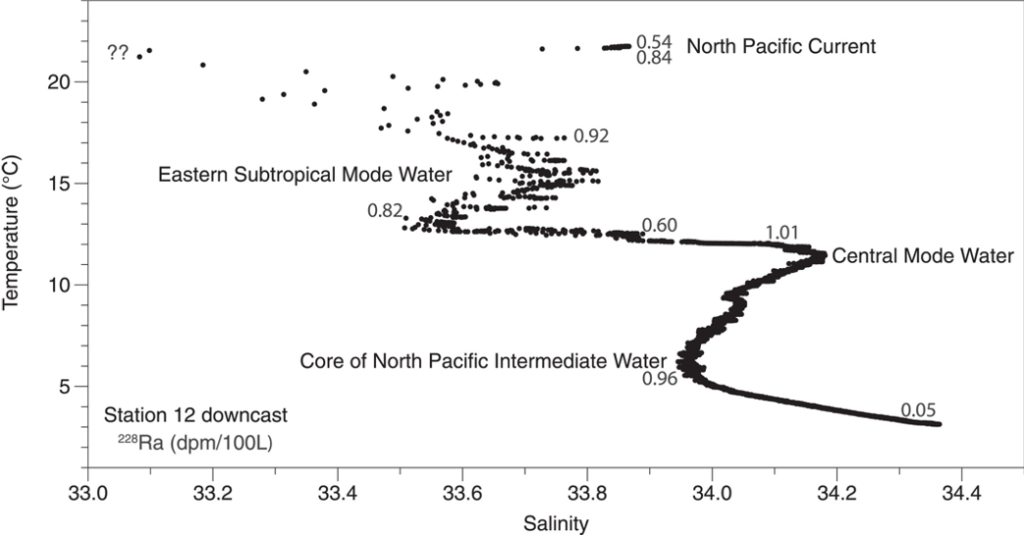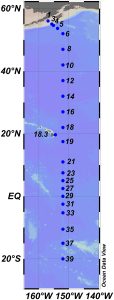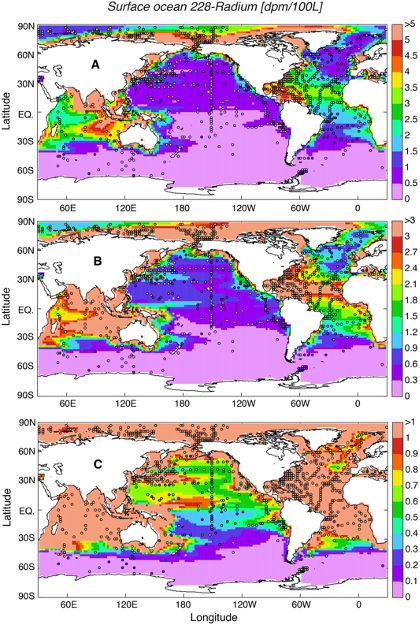North-South radium-228 section in the Pacific Ocean
The discussion of this paper published by Moore and his (2024, see reference below) colleagues proposes two different parts:
The first one shows the results of measurements of radium-228 (228Ra, half‐life = 5.75 years) along the GP15 meridional transect from Alaska to Tahiti (152°W). These data allow the authors to trace water movements and current speeds in the upper Pacific and to determine regions near the seabed where sediment‐water interactions are most intense. In the upper ocean, the circulation pattern that brought water from the Asian margin to the northeast Pacific at speeds of 2–8 cm/sec is well traced. Near the seabed they discovered a region of enhanced 228Ra activity indicating intense sediment‐water interactions. For example, between 27 and 47°N near‐bottom inventories average four times greater than the other stations on GP15, likely resulting from a sluggish circulation in this region, leading to long water residence times and 228Ra build‐up. Such regions may control the release of trace elements and isotopes (TEIs) from the seabed to the water column.
On a global scale, the second part proposes an interesting comparison of the 228Ra distribution (integrated in the near‐surface (18 m) in the Pacific compared to the Indian and Atlantic oceans. This clearly illustrates the differences in 228Ra in different oceans and emphasizes how ocean circulation features are reflected in the 228Ra abundances.


Figure 1 (left): Upper (0–1,000 m) water column profile of temperature and salinity at Station 12 (37°N, 152°W). The water masses are identified and 228Ra activities (dpm/100 L) are indicated.
Figure 2 (right): Map of GP15 transect, indicating deep stations sampled for 228Ra.

Figure 3: Three World Ocean maps are based on the integration of near-surface (18 m) distributions of 228Ra measured over the past 6 decades with a global ocean model (Kwon et al., 2014, plus GP15 data). These maps are shown at different scales to demonstrate the differences in 228Ra in different oceans and emphasize how ocean circulation features are reflected in the 228Ra abundances (a) At a scale of 0–5 dpm/100 L the Pacific Ocean is almost devoid of prominent features which are well-resolved in the Indian and Atlantic Oceans (b) At a scale of 0–3 dpm/100 L the outlines of some features in the Pacific Ocean become apparent as does the Equatorial Current system in the Atlantic (c) The lowest scale, 0–1 dpm/100 L is required to clearly define features in the Pacific Ocean, while 228Ra activities in the Indian and Atlantic Oceans are largely color saturated at >1 dpm/100 L.
References:
Moore, W. S., Charette, M. A., Henderson, P. B., Hammond, D. E., Kemnitz, N., Le Roy, E., Kwon, E. Y., & Hult, M. (2024). Enriched Regions of 228Ra Along the U.S. GEOTRACES Pacific Meridional Transect (GP15). Journal of Geophysical Research: Oceans, 129. Access the paper: 10.1029/2023jc020564
Kwon, E. Y., Kim, G., Primeau, F., Moore, W. S., Cho, H. M., Devries, T., et al. (2014). Global estimate of submarine groundwater discharge based on an observationally constrained radium isotope model. Geophysical Research Letters, 41(23), 8438–8444. Access the paper: 10.1002/2014GL061574
